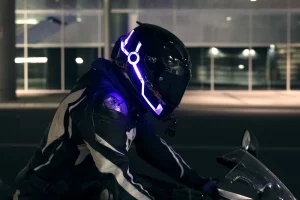Do you know the rules of the road for motorcycles in your state?
Depending on where you live and where you go, motorcycle rules may vary widely, so it’s essential to keep up to date on the laws in your state, as well as those in neighboring states.
In the end, we are confident you don’t want to end yourself on the wrong side of the law if you are a motorcyclist! A list of the most frequent motorcycle requirements in each state is provided below.

Helmet Rules For Motorcycles –
Helmets are a must-have item of riding safety equipment since they guard against brain and skull injuries that may be deadly in the event of an accident.
According to the Centres for Disease Control and Prevention, helmets may lower the risk of mortality by 37 percent and the incidence of head injuries by 69 percent in the event of an accident.
Even if your state does not require you to wear a helmet, you should still do so for your protection. While there is no regulation requiring road riders of any age to wear a helmet, studies show that doing so may lower the likelihood or severity of head and brain damage by 65 percent to 88 percent.
DOT certification and the manufacturer and model of the helmet should be printed on your helmet when you purchase it. The phrases DOT and FMVSS218 should also be on the helmet. Passengers should wear DOT-certified helmets while riding with you on your bike.
Mandatory – Helmets are required by law for all riders and passengers in several jurisdictions.
Like Texas and Florida, some states compel their riders to wear helmets. However, there are age limitations attached to this mandate. For example, most states mandate the use of a helmet for drivers who are 18 years old or younger.
Requires a helmet with a reflective tape, decal, or material to be worn under certain circumstances. When driving, this will make you more apparent to other motorists.
Just two states do not mandate motorcycle riders to wear helmets: Iowa and Illinois.
Legislation Requiring The Protection Of One’s Eyes –
Eye protection is required in several states. If you have a bike windshield, you are not required to wear eye protection in other states. 15″ above the handlebars is ideal for a windscreen.
Some states mandate eye protection for cyclists, but only under a specific age limit. In Indiana, for example, riders under the age of 18 are required to wear eye protection.
When it comes to safety, nothing beats eye protection since it shields your eyes from flying shrapnel, the wind, and other road debris. Even if it’s not a legal necessity in your jurisdiction, wearing eye protection while driving is still a good idea.
The Following Are Some Of The Best Biker Eye Protectors On The Market:
- Motorcycling goggles
- Helmet visor with DOT ratings
- Windscreens that are 15″ above your bike’s handlebars are ideal.
Helmet Laws For Motorcyclists In Alabama
Drivers and passengers in Alabama are required to wear protective headgear. Headgear must meet strict legal specifications, such as a non-shattering, external solid shell and an internal shock-absorbing cradle meant to hold the helmet and keep it apart from the wearer’s head during an impact or penetration. At all points where the head is near or may come into contact with the outer shell, the helmet’s padding must be impact-resistant, absorbent, and considerable in thickness. The materials used to construct the helmet must be long-lasting and not degrade significantly over time. It is forbidden to utilize materials that have been shown to cause skin irritation or illness.
A chin strap is also required to keep the helmet in place, and it must be permanently affixed. The chin strap must be fastened to all riders and passengers when the bike is moving. You don’t have to have an eye shield, but you can’t have one that’s more than a quarter of an inch above the helmet’s surface or its outside shell.
Helmet Laws For Motorcyclists In Alaska
As long as the driver has a motorcycle license, they aren’t needed to wear a helmet when riding a motorcycle in Alaska. When driving merely on an instructional permit, a helmet is mandatory for all drivers, young or old. All passengers must wear helmets as well. Unless the motorcycle is equipped with a windscreen or windshield, everyone must wear eye protection.
Helmet Requirements for Motorcyclists in the State of Arizona
Only drivers and passengers under the age of 18 are required to wear helmets in Arizona. If the bike has a windshield, everyone must wear goggles, sunglasses, or a transparent face shield to protect their eyes.
Motorcycle Safety Helmet Laws In Arkansas
Helmet use is mandated for all motorcycle riders under 21 in Arkansas. However, this does not apply to municipal police agencies’ use of three-wheel motorcycles with a cab and a windshield that does not exceed twenty horsepower (20 hp). All drivers and passengers, regardless of age, are required to wear eye protection.
Laws Governing The Use Of Motorcycle Helmets In California
Everyone who drives or rides a motorcycle in California must wear a helmet. The U.S. Department of Transportation and individual states require that all helmets satisfy specific safety requirements, including the use of helmet straps.
Laws Governing Motorcycle Helmets In Colorado
In Colorado, drivers and passengers under the age of 18 are only required to wear helmets. DOT-approved motorcycle helmets must be worn while the motorcycle is in motion, and the chip strap must be attached to the helmet at all times. All drivers and passengers must wear protective eyewear with safety glass or plastic lenses. Wearing a helmet with built-in eye protection eliminates the need for these add-on gadgets.
Helmet Laws For Motorcycle Riders In Delaware
Everyone under the age of 19 in Delaware is required to wear a safety helmet and appropriate eye protection. All riders over the age of 19 are required to wear a helmet and eye protection at all times while on the road.
Laws Governing The Use Of Motorcycle Helmets In Florida
Helmet laws in Florida might be a little confusing. Helmet use is mandated for all motorcycle drivers and riders. If a person over 21 is insured by motorcycle-related insurance coverage that provides at least $10,000 in medical benefits, the helmet rule does not apply. Eye protection is mandated for all motorcycle operators and riders, regardless of experience level. In the state of Florida, anybody who rides in a sidecar is exempt from the state’s helmet and eye protection rules.
Georgia’s Helmet Regulations
Wearing a helmet is mandatory for all motorcycle drivers and passengers in Georgia. In the absence of a windshield, eye protection is also necessary.
Hawaii’s Helmet Requirements for Motorcyclists
Drivers and passengers under the age of eighteen must wear a safety helmet attached around their chins with a chin strap in the state of Hawaii. If the motorcycle does not have a windshield, everyone must wear safety glasses or goggles.
Idaho’s Motorcyclists Must Wear a Helmet
Drivers and passengers under the age of 18 in Idaho must wear a helmet that meets or exceeds the Director of Motor Vehicles’ criteria for helmets. Motorcycles operated or ridden on private land are exempt from the helmet requirement.
Laws Governing The Use Of Motorcycle Helmets In The State Of Illinois
Motorcycle riders and passengers in Illinois are not required to wear helmets. A shatter-resistant clear shield is required on all motorcycles, although drivers and riders must still wear eye protection such as glasses or goggles.
Helmet Laws For Motorcyclists In Indiana
Helmet and eye protection are mandatory for all drivers and passengers under 18 in Indiana.
Iowa’s Motorcyclist Safety Helmet Requirements
The use of a motorcycle helmet is not required in Iowa. If you ride a motorcycle, you have the option of donning protective gear or not.
Helmet Laws for Motorcyclists in Kentucky
According to Kentucky law, anybody under the age of 21 operating a motor vehicle or a passenger vehicle must wear a helmet. Those who have a motorcycle permit or a license for less than a year are also obliged to wear helmets when driving. Permit holders are also prohibited from transporting people in their vehicles. Protective eyewear must be worn by all people, regardless of their age.
Louisiana Motorcycle Helmet Laws
When the motorcycle is moving, everyone in the vehicle, including the driver and passengers, must wear a helmet with a chin strap.
Helmet laws for motorcycles in the state of Maine
All passengers under the age of 18 must wear a helmet as a state law in Maine. Helmets are also required for all drivers with a learner’s permit or a license for less than a year. Helmets are required for both the driver and any passengers.
Helmet Laws for Motorcyclists in Maryland
All drivers and passengers in Maryland must wear a helmet at all times. In addition, unless the motorcycle is fitted with a windshield, all riders must wear eye protection.
Massachusetts’s Helmet Regulations
All motorcycle drivers and passengers in Massachusetts are required to wear helmets. Anyone riding in a sidecar should be aware of this as well. Additionally, if the motorcycle does not have a windshield or screen, drivers must wear eyeglasses, goggles, or a protective face shield.
Michigan’s Helmet Regulations
Helmets are mandatory for all drivers and passengers under 21 in Michigan. As long as they have at least $20,000 in first-party medical coverage and a motorcycle endorsement for at least two years, 21-year-olds may opt-out of wearing a helmet on their rides. Those above the age of 21 May opt out of wearing a helmet provided they have at least $20,000 in first-party medical benefits insurance.
Mandatory Wear of a Helmet for Motorcyclists in Minnesota
Everyone under the age of eighteen who is operating a motor vehicle in Minnesota must wear a helmet. Furthermore, all drivers must wear a helmet while behind the wheel, no matter their age. Additionally, trainee drivers are not permitted to carry passengers or travel on interstates at night. All motorists in Minnesota are required by law to wear eye protection.
Laws governing the use of motorcycle helmets in Mississippi
Helmet use is mandated by state law in Mississippi for all motorists and passengers.
Motorcycle Helmet Laws in Missouri
Helmets are mandatory for motorcycle drivers under 26 and those with an instructional permit. Health insurance is required for drivers over the age of 26 who do not wear a helmet. Every passenger must have a helmet on at all times.
Motorcycle Helmet Laws in Montana
A helmet is required for all drivers and passengers under 18 in Montana. The state’s Department of Justice has approved the use of helmets.
Helmet Laws for Motorcyclists in Nebraska
When the motorcycle is moving, everyone in the vehicle, including the driver and passengers, must wear a helmet with a chin strap. In addition, the liner and padding of the helmet must meet or exceed federal standards in Nebraska.
Laws in Nevada regarding motorcycle helmets
Motorcyclists and their passengers in Nevada are obliged to wear helmets and eye protection while on the road. You don’t have to wear goggles or face shields if you’re driving a motorcycle with a windshield.
Helmet Requirements in the State of New Hampshire
The use of a motorcycle helmet is not required in New Hampshire. Passengers and riders have the option to wear safety gear or not.
Helmet laws for motorcycles in New Jersey
No one is allowed to operate a motor vehicle without wearing a helmet in the state of New Jersey. Both sides of a helmet must be reflectorized to fulfill New Jersey’s Director of Motor Vehicles’ safety regulations. All motorcycle drivers must wear safety eyewear as well.
Helmet Requirements in the State of New Mexico
In New Mexico, drivers and passengers under the age of 18 must wear a helmet by law.
Helmet Regulations in the State of New York
Helmets are mandatory for all New York drivers and passengers. All motorcycle drivers in New York must also wear goggles or face shields.
Helmet laws in North Carolina.
All motorcycle drivers and passengers in North Carolina must wear helmets with chin straps attached.
Helmet laws for motorcycles in North Dakota
All drivers and passengers under the age of 18 in North Dakota are required to wear helmets. Regardless of the age of the passenger, a driver who is under the age of 18 must wear a helmet at all times.
Helmet laws in the state of Ohio
While driving, wearing a helmet is mandatory in Ohio for everyone under 18 and those with “novice licenses.” Motorcyclists over the age of 18 who have never had a motorcycle license in Ohio or another state or jurisdiction recognized by Ohio law may apply for a “novice license” from the state. Helmets must be worn by anybody under 18, regardless of whether the driver has a “novice” license. All drivers and passengers must wear eye protection at all times, including when operating a vehicle.
Helmet Requirements for Motorcyclists in the State of Oklahoma
Helmet use is mandated for all drivers and passengers under 18 in Oklahoma. The helmet’s liner, padding, or chin straps must not obstruct the driver’s vision. Goggles or a face shield must be worn by all drivers, save for those who ride motorcycles equipped with a windshield of adequate quality, size, and thickness.
Helmet Requirements in the State of Oregon
When riding a motorcycle in Oregon, wearing a helmet is mandatory for both the driver and the passenger. They must wear helmets that have been certified by the U.S. Department of Transportation to fulfill safety criteria (DOT).
Motorcycle Helmet Laws in Pennsylvania
In 2003, Pennsylvania abolished the requirement that drivers wear helmets. If you are above the age of 21, you no longer have to wear a helmet when riding your motorcycle if you have held your license for two years or completed a motorcycle rider safety course. When a motorcycle driver is wearing a helmet, passengers over the age of 21 are authorized to ride without one unless the driver is also compelled to wear one. No matter how old the passenger is, they must wear a helmet while traveling in the car of someone who is only getting their learner’s permit. A helmet is needed for anybody under 21 operating a vehicle, and eye protection is compulsory for everyone.
Rhode Island Helmet Regulations
Rhode Island law mandates that motorcycle drivers under 21 wear a helmet while on the road. For the first year after a person receives a motorcycle license, all new drivers must wear a helmet. All drivers are required to wear eye protection at all times when operating a motor vehicle. Helmets are mandatory for all motorcycle passengers.
State of South Dakota Motorcycle Helmet Requirements
Those under the age of 18 in South Dakota must wear a helmet when riding their motorcycle. The headgear must meet government standards. Drivers of all vehicles, including motorcycles, must wear eye protection unless the windshield is of adequate height, as mandated by law.
Motorcycle Helmet Laws in Tennessee
Crash helmets are mandatory in Tennessee for both drivers and passengers. Drivers and passengers over the age of 21 may wear any federal motor vehicle safety standards-compliant helmet. Ventilation passageways larger than 1.5 inches in diameter are also required. The American Society for Testing Materials, the Consumer Product Safety Commission, the Southern Impact Research Center, and the Snell Foundation are organizations that mandate a label on motorcycle helmets in Tennessee.
Texas Helmet Regulations
In general, Texas law mandates a helmet for all motorists and passengers. Headgear must fulfill the state’s public safety standards before being used on the road. However, there are exceptions to this rule for those 21 and over who have completed an approved motorcycle operator training and safety course or who are covered by a health insurance plan that provides at least $10,000 in medical benefits for injuries incurred while operating the motorcycle.
Utah’s Motorcyclists Must Wear Helmets
Motorcyclists and passengers under the age of 18 must wear a helmet in Utah. The helmets must meet the requirements set out by the Department of Transportation of the United States (DOT).
Helmet Laws for Motorcycles in Vermont
All motorcycle drivers and passengers in Vermont are required by law to wear a helmet. A helmet must be certified by DMV Commissioner to be used on the road. All helmets must include either a neck or chin restraint by state legislation.
Laws governing the use of motorcycle helmets in the state of Virginia
Helmet use is mandated for all motorcycle operators and passengers in Virginia. They must comply with standards set out by ANSI, the Snell Memorial Foundation (Snell), or the Department of Transportation (DOT). All motorcycle drivers in Virginia must wear a face shield, safety glasses, or goggles unless the bike is equipped with safety glass or a windshield approved by the Superintendent of the Department of Motor Vehicles or that meets or exceeds the standards and specifications of Snell, ANSI, or the federal Department of Transportation standards and specifications.
Helmet Requirements in Washington State
In Washington, it is the law that everyone on a motorcycle, including the driver, must wear a helmet. When the motorcycle is moving, the helmet must have a neck or chin strap attached firmly. A face shield or goggles are required for all riders unless the motorcycle is equipped with a windshield.
Motorcycle Helmet Regulations in Washington D.C.
All motorcyclists in the District of Columbia are required by law to wear helmets at all times. It cannot be used if a helmet does not satisfy ANSI Standard Z90-.1-1966. Helmets must be certified by the Department of Motor Vehicles (DMV) director. Helmets in the District of Columbia are also required by law to feature at least four inches of weather-resistant, permanent reflectors on each side. Neck or Chin straps are required on all helmets. Helmets must also provide an unimpeded peripheral vision of 120 degrees on each side. It is also essential that helmets allow for clear hearing.
Motorcycle drivers must wear goggles or face shields to prevent eye and head injuries unless the machine has a windshield and the rider wears safety glasses.
Helmet Requirements in the State of West Virginia
All motorcycle drivers and passengers in West Virginia must wear a helmet with a neck or chin strap that is properly attached. The helmet must be constructed to deflect and resist penetration and distribute impact forces to protect the wearer. All helmets sold in the United States must satisfy the American National Standards Institute (ANSI) Standard Z 90.1 or the Snell Safety Standards (Snell) for Protective Headgear for Vehicle Users. In addition, ANSI Standard Z2.1 requires that all motorcycle riders and passengers wear protective eyewear, eye goggles, or a face shield.
The Federal Motor Vehicle Safety Standard 205 and the ANSI Safety Glazing Materials for Glazing Motor Vehicles on Land Highways, Standard Z26.1, provide the performance requirements for motorcycle windscreens and windshields.
Motorcycle helmet laws in Wisconsin
All motorcycle drivers and passengers under the age of 18 in Wisconsin must wear a helmet with a chin strap. Regardless of age, all learners must wear a helmet while behind the wheel. Unless the motorcycle has a windshield that extends at least 15 inches above the handlebars, all riders must wear a protective face shield, glasses, or goggles.
Wyoming helmet regulations
Only those under 18 who ride motorcycles in Wyoming are obliged to wear a helmet. Helmets must be attached securely and meet the requirements set by the state’s transportation superintendent.
Conclusion
Now that you’ve read up on your state’s motorcycle regulations, you’re well-prepared to enforce them. You should also be aware of the following restrictions while riding a motorcycle:
- A motorcycle license is required to ride your bike in any state.
- All states need proof of bike ownership and registration.
- The legal age to operate a motorcycle varies from state to state, but for the most part, you must be at least 18 years old to do so.
- Interstate roads and restricted access highways prohibit motorcycles with less than 50cc engines.
Reference:






